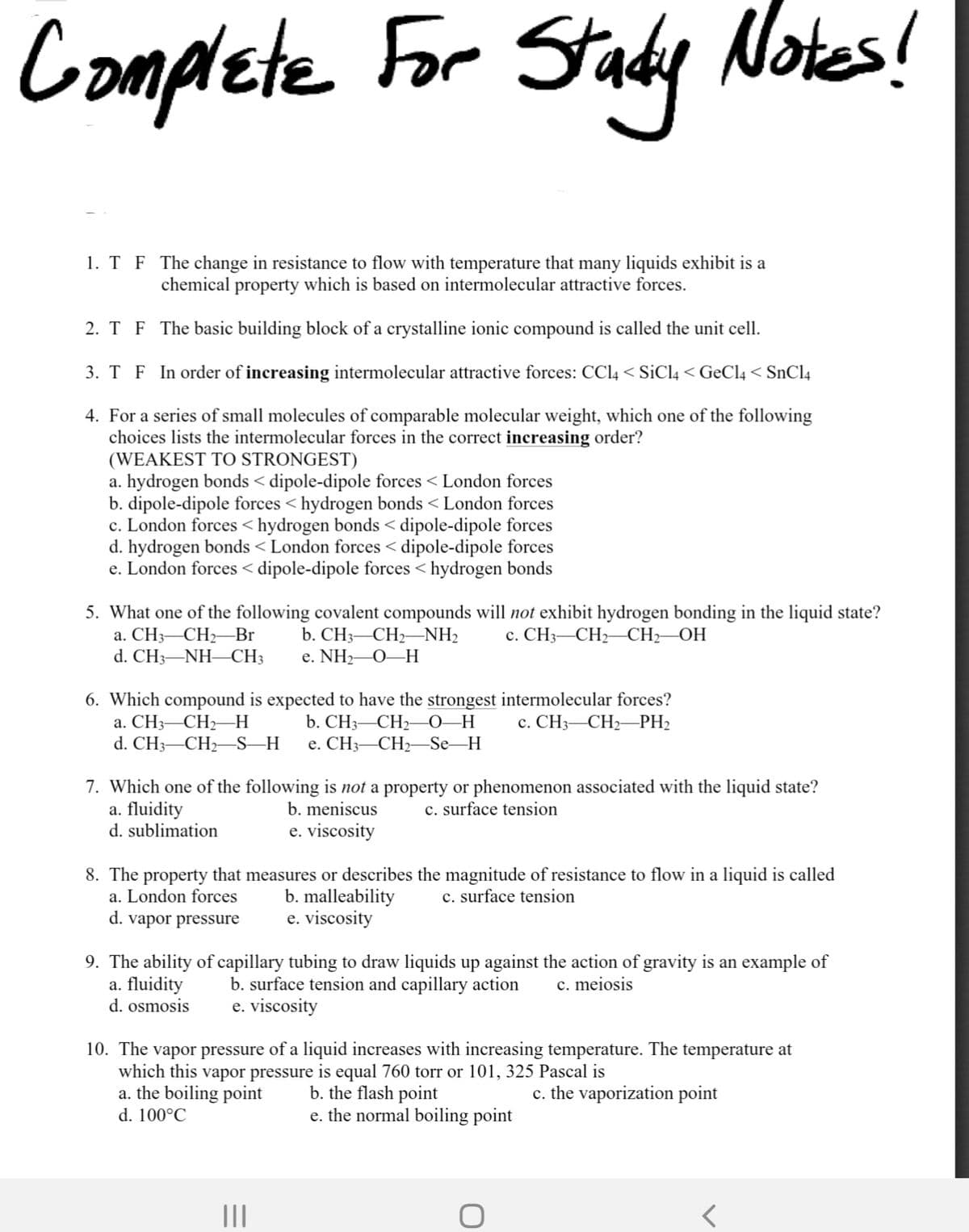7. Which one of the following is not a property or phenomenon associated with the liquid state? a. fluidity d. sublimation b. meniscus c. surface tension e. viscosity
7. Which one of the following is not a property or phenomenon associated with the liquid state? a. fluidity d. sublimation b. meniscus c. surface tension e. viscosity
Chapter10: Liquids And Solids
Section: Chapter Questions
Problem 1RQ: What are intermolecular forces? How do they differ from intramolecular forces? What are...
Related questions
Question
I need help with questions 7 & 8. Thank you

Transcribed Image Text:Complete For Stady
Notes!
1. T F The change in resistance to flow with temperature that many liquids exhibit is a
chemical property which is based on intermolecular attractive forces.
2. T F The basic building block of a crystalline ionic compound is called the unit cell.
3. T F In order of increasing intermolecular attractive forces: CCL4 < SiCl4 < GeCl4 < SnCl4
4. For a series of small molecules of comparable molecular weight, which one of the following
choices lists the intermolecular forces in the correct increasing order?
(WEAKEST TO STRONGEST)
a. hydrogen bonds < dipole-dipole forces < London forces
b. dipole-dipole forces < hydrogen bonds < London forces
c. London forces <hydrogen bonds < dipole-dipole forces
d. hydrogen bonds < London forces < dipole-dipole forces
e. London forces < dipole-dipole forces < hydrogen bonds
5. What one of the following covalent compounds will not exhibit hydrogen bonding in the liquid state?
а. СH3—СH—Br
d. CH3-NH-CH3
с. СH3—СH—CH—ОН
b. CH3-CH2–NH2
е. NHz—О—Н
6. Which compound is expected to have the strongest intermolecular forces?
b. CH3—СH— 0 —Н
е. CH —СН—Se_H
с. СНз— СН—PH2
a. CH3-CH2H
d. CH3-CH2-S–H
7. Which one of the following is not a property or phenomenon associated with the liquid state?
a. fluidity
d. sublimation
b. meniscus
c. surface tension
e. viscosity
8. The property that measures or describes the magnitude of resistance to flow in a liquid is called
a. London forces
c. surface tension
b. malleability
e. viscosity
d. vapor pressure
9. The ability of capillary tubing to draw liquids up against the action of gravity is an example of
a. fluidity
d. osmosis
b. surface tension and capillary action
e. viscosity
c. meiosis
10. The vapor pressure of a liquid increases with increasing temperature. The temperature at
which this vapor pressure is equal 760 torr or 101, 325 Pascal is
a. the boiling point
d. 100°C
b. the flash point
e. the normal boiling point
c. the vaporization point
II
Expert Solution
This question has been solved!
Explore an expertly crafted, step-by-step solution for a thorough understanding of key concepts.
This is a popular solution!
Trending now
This is a popular solution!
Step by step
Solved in 2 steps

Knowledge Booster
Learn more about
Need a deep-dive on the concept behind this application? Look no further. Learn more about this topic, chemistry and related others by exploring similar questions and additional content below.Recommended textbooks for you


Chemistry: An Atoms First Approach
Chemistry
ISBN:
9781305079243
Author:
Steven S. Zumdahl, Susan A. Zumdahl
Publisher:
Cengage Learning

Chemistry
Chemistry
ISBN:
9781305957404
Author:
Steven S. Zumdahl, Susan A. Zumdahl, Donald J. DeCoste
Publisher:
Cengage Learning


Chemistry: An Atoms First Approach
Chemistry
ISBN:
9781305079243
Author:
Steven S. Zumdahl, Susan A. Zumdahl
Publisher:
Cengage Learning

Chemistry
Chemistry
ISBN:
9781305957404
Author:
Steven S. Zumdahl, Susan A. Zumdahl, Donald J. DeCoste
Publisher:
Cengage Learning

Chemistry for Engineering Students
Chemistry
ISBN:
9781337398909
Author:
Lawrence S. Brown, Tom Holme
Publisher:
Cengage Learning

Chemistry: The Molecular Science
Chemistry
ISBN:
9781285199047
Author:
John W. Moore, Conrad L. Stanitski
Publisher:
Cengage Learning

General Chemistry - Standalone book (MindTap Cour…
Chemistry
ISBN:
9781305580343
Author:
Steven D. Gammon, Ebbing, Darrell Ebbing, Steven D., Darrell; Gammon, Darrell Ebbing; Steven D. Gammon, Darrell D.; Gammon, Ebbing; Steven D. Gammon; Darrell
Publisher:
Cengage Learning